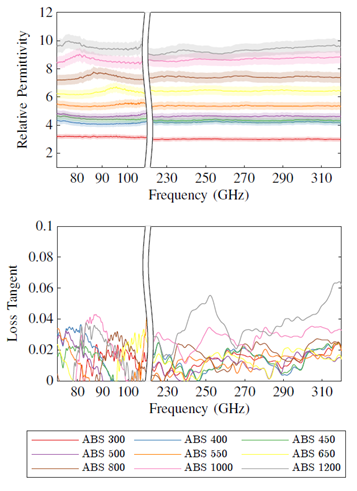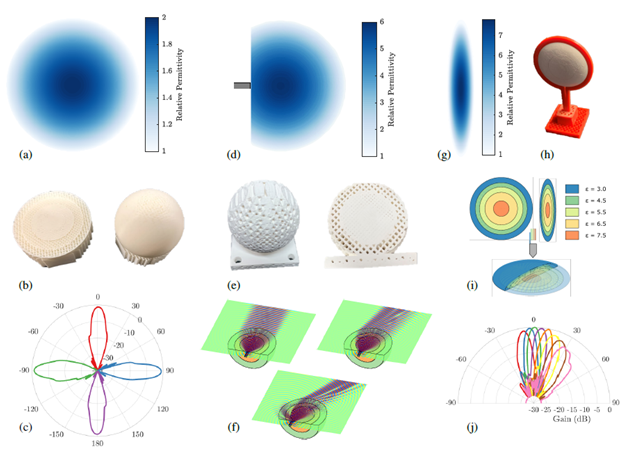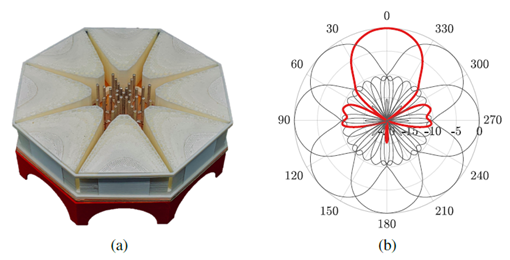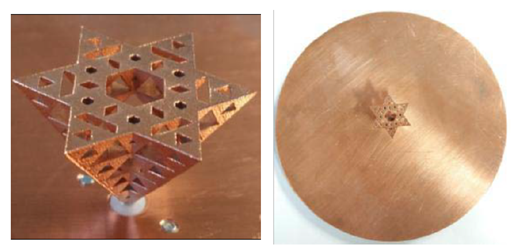An Overview of 3D Printed Antennas for 5G Communications and Beyond
Henry Giddens, and Yang Hao, Queen Mary University of London
IEEE Future Networks Tech Focus, Volume 4, Issue 1, November 2020
Abstract
5G communication systems will once again revolutionize the ways that people connect and communicate with each other. Future mobile networks will also span new frequency bands in mm-wave and THz bands. The combination of the need to wirelessly connect everyday consumer devices to the internet, and the range of new frequency bands on offer, has necessitated research into new antenna systems. One technology that is enabling the realization of a new class of antennas is 3D printing. This has been fueled in part by the rise of new antenna design techniques such as transformation optics and topological optimization, whilst further developments in new filament materials designed specifically for electromagnetic applications means complex antenna geometries can now be easily realized. This article presents an overview of the ways in which additive manufacturing is enabling the development of novel antennas for 5G wireless networks and beyond.
1. Introduction
The 5th generation of mobile communications will once again offer vast improvements in bandwidth and coverage, which will translate into a user experience of fast download speeds and an uninterrupted connection to the network. The antennas used in these networks will need to facilitate these features whilst maintaining low profile and conformal physical dimensions so that they can be included in consumer devices and access points. At the mm-wave bands, directive communications is essential to overcome the higher path loss and steerable beams will be required to communicate with mobile targets. Future communication networks will look to utilize even high frequencies, approaching the THz bands and sub-millimeter wavelengths. Antennas will also have to support wide input-impedance bandwidths, whilst maintaining good radiation efficiency and reliable radiation patterns. In this article we look at how 3D printing is addressing these issues. The rapid rise and falling cost of 3D printing technology over the last 10 years has generated a growing industry estimated to be worth over $10 billion in 2020 [1]. In technology-focusses industries this has manifested itself in small-scale manufacturing and rapid prototyping of new de- vices. In recent years, antenna research has taken advantage of the possibilities offered by additive manufacturing techniques. For example, antennas with complex spacial material profiles can now be realized with various 3D printing techniques. Furthermore, new design techniques for conformal antennas such as transformation optics and multi-objective topological optimization are being utilized which are particularly suited to generating printable antennas [2], [3]. Metallic printing has allowed engineers to manufacture new types of antennas up to THz frequencies, whilst 3D printing has also contributed to the realization of microwave metamaterial antennas.
2. Materials and Printing Techniques
A number of 3D printing techniques have been used for printing antenna and electromagnetic structures. These include fused deposition modeling (FDM), also known as fused filament fabrication (FFF), Polyjet printing, stereo lithography (SLA), micro-SLA and photonic polymerization. Each method has advantages and trade-offs which are suited to manufacturing different types of antennas. For example, FDM, where filament materials are extruded from a heated nozzle, is generally the cheapest 3D printing technique available, whilst it also benefits from a wide variety of filaments and can print with multiple materials in a single print. The SLA and polymerization techniques use laser or UV light to cure resin materials into the desired 3D shape. As a result, they can achieve a much higher resolution when compared to FDM, down to the 10s of nanometers scale. They are better suited to fabrication of smaller structures, and therefore are used to fabricate antennas operating in mm-wave and THz frequency bands. The materials used in these printers are essentially a light curable resin, and subsequently cannot be modified to the extent that FDM filaments have been.
3D printing has most commonly been used for manufacturing dielectric-based antennas. This is due to the fact that printing dielectric materials is far easier than printing conductive filaments. Dielectric materials can be printed using fused deposition modeling (FDM) 3D printers that can be purchased for just a few hundred dollars, whilst standard filament materials such as ABS (Acrylonitrile butadiene styrene, a common thermoplastic) and PLA (polylactic acid, a biodegradable thermoplastic polyester) have been shown to have low dielectric losses up to 100s of GHz [4]. Furthermore, specialized dielectric filaments are available for electromagnetic (EM) applications with tailored dielectric constants up to a value of 12 [5]. Fig. 1 shows the measured dielectric properties of a selection of Preperm filaments for two mm- wave frequency bands, 70-110 GHz and 220-320 GHz. All filaments are stable with frequency and the losses only become significant for the highest permittivity materials when the frequency exceeds 200 GHz.

Figure 1. Measured relative permittivity and loss tangent of electromagnetic dielectric filaments available from PREPERM [5] at mm-wave frequencies. The filaments were printed using a Prusa i3 MK3s 3D printer into 20 x 20 mm samples with 100% fill factor and measured using a quasi-optical transmissometer. The shaded area shows the error boundary associated with the measured data.
Antennas with gradient-index material profiles (i.e. materials that have spatially varying dielectric properties) are uniquely suited to 3D printing for a number of reasons. From the effective-medium theory it is possible to predict the effective permittivity of a volume of material where only a percentage of that volume is filled with a dielectric filament, and the rest of the volume by air. 3D printed dielectric metamaterials can easily be printed to obtain precise effective permittivity, and this can be further varied throughout the total volume of the antenna to obtain graded-index materials so long as the unit cell dimensions are significantly smaller than the wavelength. Multi-material 3D printing can be used to extend both the range and steepness of the dielectric gradient which opens up new possibilities in the antenna design [6].
3. Dielectric Antennas
Due to the ease of printing dielectrics compared to conductive materials, 3D printing is best suited to fabricating dielectric antennas such as lenses and DRAs. Lens have been demonstrated using almost all the common 3D printing methodologies spanning a wide range of frequencies from microwaves through the mm-wave bands and up to THz. Lens antennas are particularly suited to mm-wave 5G frequency bands as they generate directive radiation, are not physically large due to the small wavelength, and can also have beam steerable capabilities, whilst the wavelength is not so small as to be beyond the resolution of FDM 3D printers. The Luneburg lens for example, is a multi-focal lens able to concentrate a plane wave impeding on any surface to a point on the opposite surface of the lens, requires a material profile with permittivity of 2 in the center and 1 on the surface [7], as shown in Fig. 2 (a - c). Whilst the Luneburg lens has been known to optical engineers since it was proposed by Rudolf Luneburg in 1944, 3D printing has offered a simple solution for easy fabrication. In order to adapt the Luneburg lens and make it more practical for real-world applications, various geometrical modifications to the Luneburg lens have been demonstrated through trans- formation optics coordinate transformations. These include the Gutman lens Fig. 2 (d-f) [8], the compressed Luneburg lens Fig. 2 (g - j) [9], and the flat Luneburg lens [10]. Each of these modifications requires a more complex material profile, however they can be realized using the 3D printing techniques previously described. Each modification to the Luneburg lens importantly retains the key feature of generating directive, steerable beams which are necessary for 5G mm-wave and future THz communication links. Fig. 2 shows some examples of the various Luneburg Lenses which have been 3D printed for mmWave beam scanning applications. The lenses are often excited using traditional antenna elements such as patches, waveguide probes and horns, with the lens taking the role of shaping and steering the antenna beam.
Lens antennas at THz frequencies will form a key element in THz communication systems as they are wideband devices and generate the directive beams necessitated by the small wavelength and high path loss. 3D printed THz lenses have been demonstrated through micro SLA 3D printing, which are able to print with sub-micron resolution [11] that is require to generate graded-index interfaces at THz wavelengths. A number of diffractive lenses operating at 0.625 THz were demonstrated in [12] using low cost 3D printing techniques.
3D printing has also been use to realize antennas in specialist radios where customized designs are required. For example, an 8-beam lens operating in military mobile-adhoc networks with multi-functionality and 360° coverage was presented in [6]. The lens, shown in Fig. 3, is able to radiate with an optimized 45° beamwidth in each of its 8 sectors, but can switch to multi-beam mode covering 8 directions in any one instance due to the symmetry of the lens. The lens was 3D printed using multi-material printing with a permittivity gradient ranging from 3.6 on the edge to 1 in the center, and takes a conformal octagonal shape.
Dielectric resonator antennas offer unique advantages over traditional antennas, such as a reduced size whilst maintaining a wide input impedance bandwidth and good radiation efficiency, which can be beneficial to 5G communications networks. 3D printing has also opened up new possibilities in dielectric resonator antenna research. For example, the gradient-index DRA presented in [13] and shown in Fig. 4 excites three transverse modes which are merged together to provide a wide input impedance bandwidth from 4 - 8 GHz. 3D printed DRA arrays have also been demonstrated as high- gain access point antennas [14], and the technology has been further applied to mm-wave frequencies [15].

Figure 2. An overview of beam steerable 3D printed lens antennas for mmWave communications. (a) - Permittivity distribution of a classic Luneburg lens antenna [7]. (b) - Photograph of 3D printed Luneburg Lens antenna using effective medium theory. (c) - Measured radiation patterns at 28 GHz with feed position at 0◦, 90◦, -90◦, and 180◦. (d) - Permittivity distribution of the Gutman lens with the focal point moved to a position of 0.45R [8]. (e) Photograph of the 3D printed Gutman lens at 60 GHz. (f) - Simulated electric field patterns showing beam steering as the feed position is moved along the flat face of the lens. (g) - Permittivity distribution of a compressed Luneburg lens [9]. (h) - photograph of the 3D printed compressed Luneburg lens at 84 GHz. (i) - Setup for multi-material 3D printing of the compressed lens with 5 different filaments. (j) - Measured radiation patterns of the compressed lens at 84 GHz. All measurements and fabrication of lens antennas performed at Queen Mary University London.

Figure 3. 3D-printed 8-beam dielectric lens antenna with multi-functionality including optimized 45° radiation pattern [6].

Figure 4. A graded-index 3D-printed dielectric resonator antennas with 3 transverse modes and wide input impedance bandwidth [13].
4. Metallic Antennas
Most traditional antenna structures require a conductive element in order to interface with the input port and provide resonance. 3D printing conductive materials for electromagnetic applications remains a challenging problem for a number of reasons. Poor conductors, which are acceptable for 3D printed electronic circuits, are not suited to antenna applications as the losses severely impact radiation efficiencies. However, conductive filaments have recently become commercially available which may offer some potential, such as the Multi3D Electrificonductive filament with a quoted volume resistivity of 0.006 Ω cm [16]. For purely metallic antennas, specialist metal 3D printers are an alternative option. These can directly print the metallic materials including aluminum, steel, titanium and cobalt through direct metal laser sintering (DMLS). For example, Jun et. al. 3D printed fractal monopole antennas (Fig. 5) using metal AM which have ultra-wideband radiation characteristics and geometries that would be difficult to realize using subtractive manufacturing methods [17]. Metallic printing has also been used to fabricate horn antennas and waveguides at 110-170 GHz [18], although surface roughness and layer height can become an issue at submillimeter wavelengths. Metallic printing is likely to be widely utilized to fabricate mmWave and THz antennas that required intricate 3D geometries that traditional techniques are incapable of achieving.

Figure 5. Fractal monopole antenna using metallic AM technology [17].
An alternative and cost effective approach for 3D printing metallized antenna parts is to print using a regular filament or resins, and then coat the parts in conductive materials [19–22]. This allows the intricate and detailed 3D shapes associated with additive manufacturing techniques to be incorporated into antenna technologies, has a much lower material cost than pure metal antennas, and has other advantages in terms of weight [21]. 4 different coating techniques, Jet Metal Processing (JMT), aerosol spray coating using copper and nickel conductive paints, and brush painting with electrolube silver conductive paint, were analyzed in [20]. JMT is able to achieve performance comparable to PEC antennas at both 10 GHz and 30 GHz. Metal-coated 3D printed parabolic mirrors have also been demonstrated with nanometer scale surface roughness for THz applications [22]. Low cost metallization techniques clearly offer possibilities for mass production of low cost 3D printed antennas for 5G, mm-wave and THz communications.
5. Metamaterials
Metamaterials are artificially designed periodic structures which can be designed to have properties which are not found in naturally occurring materials. Electromagnetic metamate- rials have been demonstrated with negative refractive index components for applications such as cloaking. Metamaterials can also be utilized in more practical applications including wireless communication. 3D printing is a valuable tool for further innovation in this field, as it allows multiple materials to be combined in complex structures that will give an optimal material response. For example, a chequerboard dielectric metamaterial with anisotropic properties was 3D printed in [23] using two high-contrast dielectric filaments. The authors in [24] 3D printed a broadband microwave metamaterial with customized permittivity and permeability using the electrificonductive filament.
6. Summary
In summary, it is clear that 3D printing has already had a significant impact on antenna related research and development. With incoming 5G networks and trends for future communications systems moving to higher frequencies, additive manufacturing technology will become increasingly important to the industry. It is expected that widely available and low cost 3D printing techniques, such as FDM and SLA, as well as the more specialist additive manufacturing methods, including Nano-scale photonic printers and metallic 3D printing, will all contribute to the continued development and manufacture of novel antennas for wireless networks.
References
- “Global 3D printing industry market size,” library Catalog: www.statista.com. [Online]. Available: https://www.statista.com/ statistics/315386/global-market-for-3d-printers/
- O. Quevedo-Teruel, W. Tang, R. C. Mitchell-Thomas, A. Dyke, H. Dyke, L. Zhang, S. Haq, and Y. Hao, “Transformation optics for antennas: why limit the bandwidth with metamaterials?” Scientific Reports, vol. 3, no. 1, p. 1903, May 2013.
- T. Maruyama, K. Yamamori, and Y. Kuwahara, “Design of Multibeam Dielectric Lens Antennas by Multiobjective Optimization,” IEEE Trans- actions on Antennas and Propagation, vol. 57, no. 1, pp. 57–63, Jan. 2009.
- J. M. Felcio, C. A. Fernandes, and J. R. Costa, “Complex permittivity and anisotropy measurement of 3D-printed PLA at microwaves and millimeter-waves,” in 2016 22nd International Conference on Applied Electromagnetics and Communications (ICECOM), Sep. 2016, pp. 1–6.
- “3D Filaments for Quick Prototyping,” library Catalog: www.preperm.com. [Online]. Available: https://www.preperm.com/ webshop/product-category/3d-filaments/
- H. Giddens and Y. Hao, “Multi-Beam Graded Dielectric Lens Antenna from Multi-Material 3D Printing,” IEEE Transactions on Antennas and Propagation, pp. 1–1, 2020.
- R. K. Luneburg, Mathematical Theory of Optics. University of California Press, 1966, google-Books-ID: VIZAy68oFiMC.
- A. S. Gutman, “Modified Luneberg Lens,” Journal of Applied Physics, vol. 25, no. 7, pp. 855–859, Jul. 1954.
- A. Demetriadou and Y. Hao, “Slim Luneburg lens for antenna applica- tions,” Optics Express, vol. 19, no. 21, pp. 19 925–19 934, Oct. 2011.
- C. Mateo-Segura, A. Dyke, H. Dyke, S. Haq, and Y. Hao, “Flat Luneburg Lens via Transformation Optics for Directive Antenna Applications,” IEEE Transactions on Antennas and Propagation, vol. 62, no. 4, pp. 1945–1953, Apr. 2014.
- F. Zhou, W. Cao, B. Dong, T. Reissman, W. Zhang, and C. Sun, “Additive Manufacturing of a 3D Terahertz Gradient-Refractive Index Lens,” Advanced Optical Materials, vol. 4, no. 7, pp. 1034–1040, 2016.
- W. D. Furlan, V. Ferrando, J. A. Monsoriu, P. Zagrajek, E. Czerwiska, and M. Szustakowski, “3D printed diffractive terahertz lenses,” Optics Letters, vol. 41, no. 8, pp. 1748–1751, Apr. 2016.
- Z.-X. Xia, K. W. Leung, and K. Lu, “3-D-Printed Wideband Multi-Ring Dielectric Resonator Antenna,” IEEE Antennas and Wireless Propaga- tion Letters, vol. 18, no. 10, pp. 2110–2114, 2019.
- A. A. Althuwayb, K. A. Abdalmalak, C. S. Lee, G. Santamara-Botello, L. E. Garca-Castillo, D. Segovia-Vargas, and L. E. Garca-Muoz, “3-D- Printed Dielectric Resonator Antenna Arrays Based on Standing-Wave Feeding Approach,” IEEE Antennas and Wireless Propagation Letters, vol. 18, no. 10, pp. 2180–2183, 2019.
- D. C. Lugo, R. A. Ramirez, J. Castro, J. Wang, and T. M. Weller, “3D printed multilayer mm-wave dielectric rod antenna with enhanced gain,” in 2017 IEEE International Symposium on Antennas and Propagation USNC/URSI National Radio Science Meeting, Jul. 2017, pp. 1247–1248, iSSN: 1947-1491.
- “Electrifi Conductive Filament.” [Online]. Available: https://www. multi3dllc.com/product/electrifi/
- S. Y. Jun, B. Sanz-Izquierdo, E. A. Parker, D. Bird, and A. McClelland, “Manufacturing Considerations in the 3-D Printing of Fractal Antennas,” IEEE Transactions on Components, Packaging and Manufacturing Tech- nology, vol. 7, no. 11, pp. 1891–1898, Nov. 2017.
- B. Zhang, Z. Zhan, Y. Cao, H. Gulan, P. Linnr, J. Sun, T. Zwick, and H. Zirath, “Metallic 3-D Printed Antennas for Millimeter- and Submillimeter Wave Applications,” IEEE Transactions on Terahertz Science and Technology, vol. 6, no. 4, pp. 592–600, Jul. 2016.
- S. Alkaraki, A. S. Andy, Y. Gao, K.-F. Tong, Z. Ying, R. Donnan, and C. Parini, “Compact and Low-Cost 3-D Printed Antennas Metalized Using Spray-Coating Technology for 5G mm-Wave Communication Systems,” IEEE Antennas and Wireless Propagation Letters, vol. 17, no. 11, pp. 2051–2055, 2018.
- S. Alkaraki, Y. Gao, M. O. Munoz Torrico, S. Stremsdoerfer, E. Gayets, and C. Parini, “Performance Comparison of Simple and Low Cost Metallization Techniques for 3D Printed Antennas at 10 GHz and 30 GHz,” IEEE Access, vol. 6, pp. 64 261–64 269, 2018.
- D. Shamvedi, O. J. McCarthy, E. O’Donoghue, P. O’Leary, and R. Raghavendra, “Improving the Strength-to-Weight Ratio of 3-D Printed Antennas: Metal Versus Polymer,” IEEE Antennas and Wireless Propagation Letters, vol. 17, no. 11, pp. 2065–2069, 2018.
- N. Vaidya and O. Solgaard, “3D printed optics with nanometer scale surface roughness,” Microsystems & Nanoengineering, vol. 4, no. 1, pp. 1–8, Jul. 2018.
- D. V. Isakov, Q. Lei, F. Castles, C. J. Stevens, C. R. M. Grovenor, and P. S. Grant, “3D printed anisotropic dielectric composite with meta- material features,” Materials & Design, vol. 93, pp. 423–430, Mar. 2016.
- Y. Xie, S. Ye, C. Reyes, P. Sithikong, B.-I. Popa, B. J. Wiley, and S. A. Cummer, “Microwave metamaterials made by fused deposition 3D printing of a highly conductive copper-based filament,” Applied Physics Letters, vol. 110, no. 18, p. 181903, May 2017.
Biography
Yang Hao is a Professor of Antennas and Electromagnetics at Queen Mary University of London. He also serves in the management team of Cambridge Graphene Centre since 2013. He is active in a number of areas, including computational electromagnetics, microwave metamaterials and transformation optics, antennas and radio propagation for body centric wireless networks, active antennas for millimeter/sub-millimeter applications and photonic integrated antennas. He co-published two books: “Antennas and Radio Propagation for Body-Centric Wireless Communications”, and “FDTD modelling of Metamaterials: Theory and Applications”. He has published more than 200 journal papers and is a frequent keynote speaker for many conferences. Prof. Hao was the Editor-in-Chief for the IEEE ANTENNAS AND WIRELESS PROPAGATION LETTERS. He founded a new open access journal and is now the Editor-in-Chief of EPJ Applied Metamaterials.
He won 2015 IET AF Harvey Research Prize and is a co-recipient of BAE Chairman’s Silver Award in 2014 and the Royal Society Wolfson Research Merit Award. Prof. Hao is an elected Fellow of Royal Academy of Engineering, IEEE and IET.
Professor Yang Hao received the Ph.D. degree from the Centre for Communications Research (CCR) at the University of Bristol, U.K. in 1998. From 1998 to 2000, he was a postdoc research fellow at the School of Electrical and Electronic Engineering, University of Birmingham, U.K.
Subscribe to Tech Focus
Join our IEEE Future Networks Technical Community and receive IEEE Future NetworksTech Focus delivered to your email.
Article Contributions Welcome
Submit Manuscript via Track Chair
Author guidelines can be found here.
Other Future Networks Publications
IEEE Future Networks Tech Focus Editorial Board
Rod Waterhouse, Editor-in-Chief
Mithun Mukherjee, Managing Editor
Imran Shafique Ansari
Anwer Al-Dulaimi
Stefano Buzzi
Yunlong Cai
Zhi Ning Chen
Panagiotis Demestichas
Ashutosh Dutta
Yang Hao
Gerry Hayes
Chih-Lin I
James Irvine
Meng Lu
Amine Maaref
Thas Nirmalathas
Sen Wang
Shugong Xu
Haijun Zhang
Glaucio Haroldo Silva de Carvalho

